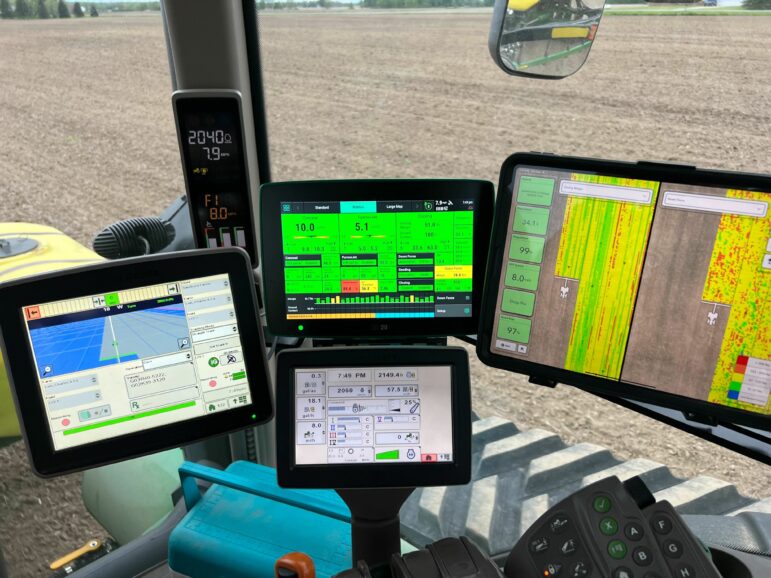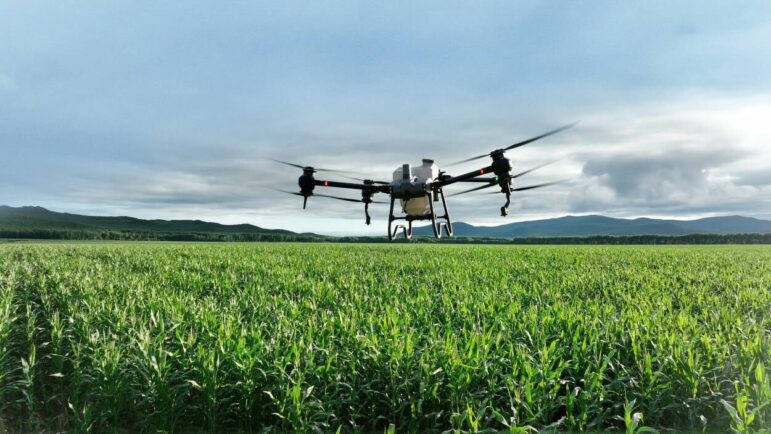
Michigan Farm Bureau
Jeff Sandborn is a farmer in Portland and represents Ionia, Barry, Kent, Ottawa and Allegan counties on the Michigan Farm Bureau’s board of directors.By ANISH TOPIWALA
Capital News Service
LANSING – Precision agriculture technology has been evolving over the past decades, and farming has become more productive and efficient with the further implementation of artificial intelligence.
A 2023 study by the U.S. Department of Agriculture found only 27% of farms and ranches nationally used such precision agriculture practices, but the rate was around 40% in Michigan.
Such practices involve the use of technology like GPS for yield monitoring and soil sampling, automation of steering equipment and – more recently – artificial intelligence to interpret data and monitor livestock and crops.
Jeff Sandborn, a Portland farmer and member of the Michigan Farm Bureau board of directors, says that every farmer uses precision agriculture practices in some way today.
“Farming’s unique,” said Sandborn, who represents Ionia, Barry, Kent, Ottawa and Allegan counties on the organization’s board. “Everybody does things a little differently.”
One thing common among many farmers, according to Sandborn, is the struggle to find employees, “especially with this technology. It takes a certain level of knowledge to be able to run this equipment.”
One essential piece of technology Sandborn uses are tractors equipped with autonomy-based technology like sensors, radar and cameras. “Autonomy is the big thing,” he said.
Robotics also play a significant role when it comes to specialty crops and sorting through produce.
Autonomous technologies save labor as well as enabling farms to more efficiently perform daily tasks like tilling, spraying fields with herbicides and fertilizing with drones, according to Sandborn.
“Any operation with crops is very time-sensitive,” Sandborn said. “Mother Nature gives us a window – in the spring to plant and the fall to harvest – and it seems like those windows can be getting narrower.”
“The goal is to maximize everything as much as you can,” he said.
Usually these practices are also the best way to protect the environment, Sandborn said.
He said a major gap with these technologies is lack of data standards which creates problems when working with multiple types of software or equipment.
“It used to be that everybody had their own unique file format or was protecting the data, even though the farmer owned it,” Sandborn said. “It wouldn’t get released in a way that was usable on another software platform.”
In his view, technology not only benefits producers but consumers as well.
“Farms have gotten bigger and it’s harder to find labor, so the best thing we can do is to have a stable food system to keep everybody fed,” Sandborn said.
Timothy Boring, the director of the Department of Agriculture and Rural Development, emphasizes the importance of agriculture precision technologies.
“We’re lowering costs a bit on what production looks like on a field-by-field basis, and we have a better sense of what it takes to grow a crop,” Boring said.
Boring pointed to the cost of replacing older equipment with newer technology or retrofitting existing equipment with updated systems.
Agriculture precision practices are constantly innovating. Artificial intelligence is one of the main areas that farmers and engineers use to improve farming.
“We generate a lot of yield maps that, frankly, just aren’t utilized to their fullest potential today,” Boring said. “We increasingly have better access to remote sensing data, whether that’s through drones, satellite imagery.”
Daniel Uyeh, an assistant professor of biosystems and agricultural engineering at Michigan State University, is working with artificial intelligence to improve farming.
“Everyone is waiting for the growing season to do experiments because the winter is just too cold and nobody is growing anything,” Uyeh said.
Uyeh said he and a few colleagues began a project to develop a digital environment, powered by artificial intelligence, to conduct experiments year-round and then use the best results during the growing season.
“It’s a very ambitious dream, but we’re hoping that we’ll get there because our primary results have shown really good promises,” Uyeh said.
“The question is usability,” Uyeh said. “We don’t know how useful it will be for growers at this point in time, but definitely for researchers working in this area. That would translate to the growers too.”
Uyeh said the goal is to put tangible results in the hands of researchers in three years.
Daniel Morris, another MSU professor, also employs artificial intelligence to develop new technology.
Morris works in the area of precision livestock farming with his focus on monitoring the animals.
Morris said, “How can we put eyes in a farm that provides real-time insights for a farmer to see if one of the animals is lame or isn’t eating or has other problems?”
Morris works with artificial intelligence to create this technology to assist farmers in monitoring the health of their livestock.
That’s through specialized cameras with automated tracking of livestock, according to Morris.
Morris and his peers have created a start-up company around the device called Motion Grazer AI and want a working prototype ready for use in the coming months.
Uyeh stressed the importance of innovation in farming and how it is an unappealing career for many young people.
“What would be the future of agriculture in this country if young people are not attracted to this area? The goal here is to make agriculture really attractive,” he said.

Courtesy of Jeff Sandborn.
Interior of a planter tractor.
Courtesy of Jeff Sandborn
A DJI T40 spray drone.